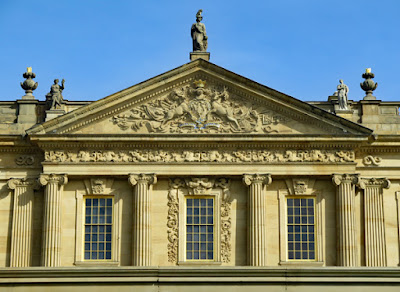Having spent the best part of two hours exploring the village of Edensor and St. Peter’s church, I was about to set off across the park to Chatsworth House when the heavens opened and, although I was able to take advantage of the nearby Edensor Tea Cottage, the timing of the return bus journey to Sheffield meant that I could only quickly explore Chatsworth Park.
Except for a couple of occasions, when I had passed through Chatsworth Park on the way to Bakewell and Haddon Hall back in 2016, I hadn’t seen Chatsworth House for nearly 35 years and when it came into view I was struck how clean it looked.
Unknown to me, a £14 million programme of cleaning and restoration had been carried out in 2012/13, which required the reopening of the Burntwood Quarry at Beeley, which was one of the six original quarry sources of Ashover Grit used in the construction of the house.
 |
| The Neoclassical Chatsworth House |
Chatsworth House is essentially divided into two distinct parts, the original Neoclassical style house built by the first Duke (1687-1707) and the north wing and further additions by William Cavendish, the 6th Duke (1822-1842), who was also reponsible for substantially expanding the gardens and rebuilding Edensor.
It is the original house, which replaced the one built by Bess of Hardwick, that has always interested me most and, after quickly looking at the bridge over the River Derwent by James Paine c. 1761 – which contains reused Portland stone statuary carved by Caius Gabriel Cibber – I took a few photos of its architectural details.
Having worked as a site manager for the restoration of the frieze sculpture on the Royal Exchange, and seen many others carved in Portland stone in London, I was very impressed by the very ornate pediment of the west front of Chatsworth House.
Unlike Portland stone, the coarse sandstones from the Millstone Grit are sometimes quite difficult to finely carve and they are mainly used for dressings. Although I could only discern their quality by zooming in with my camera and blowing them up on screen, the details – especially the antlers of the deer that form part of the Cavendish crest, and the various ancient weapons that form the background to this – are quite exceptional.
The cost of producing this kind of work is very substantial and, having only seen others like this on several buildings in London, I was extremely surprised to see that the retaining wall to the formal garden to the west of the house is also decorated with relief sculptures of similar quality, as well as two large sphinxes set on large plinths – also carved by Cibber.
With less than 20 minutes left before I had to catch the 218 bus back to Sheffield, I took a very quick look at Queen Mary’s Bower and the North Gateway, where the massive sandstone used for this addition to the house has distinct Liesegang rings.
I finished my brief exploration of Chatsworth Park at the Stable Block - also designed by Paine. As with Wentworth Woodhouse, which probably matched Chatsworth House for prestige in its heyday, its grandeur is quite remarkable when considering that such a fine example of architecture was solely designed as a place to keep horses.
 |
| A detail of the Stable Block at Chatsworth House |









Really beautifull...!
ReplyDelete